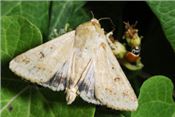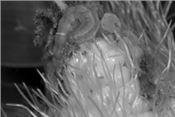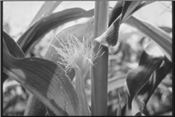|
Managing Corn Earworm Begins Early

FIGURE 2. Weekly numbers of adult corn earworm moth are monitored with pheromone traps.
DR. RIC BESSIN
PRINCETON, KY.
Corn earworm is typically a pest of later-season sweet corn, so why should we bother with worrying about it in May? We are a long way off from the start of harvest, which usually begins close to the 4th of July. But management needs to begin early for corn earworm, and one practice that helps to reduce corn earworm is to avoid later plantings if possible. Otherwise, prepare for more corn earworm pressure with plantings after June 1.
If we consider acreage, sweet corn is our most widely grown vegetable in Kentucky. Locally-grown sweet corn is very popular and in some ways, the first local sweet corn of the year signals the start of summer. While many people look forward to sweet corn, no one likes to find corn earworm in their ear. Corn earworm is the most difficult and common of our sweet corn insect pests. Corn earworm is the caterpillar that feeds on the kernels at the tip of the ear (Figure 1). The husks leaves hide the earworm and its damage until they are peeled away. More often than not, only a single corn earworm is found in a damaged ear tip as the larger caterpillars are cannibalistic on smaller ones. While backyard gardeners may not mind cutting off the tips of damaged ears, earworms can ruin the reputation of a commercial producer.
Corn earworm can overwinter locally in the soil and winter weather conditions can impact survival of these (Figure 2). As we had a very mild winter with minimal if any soil freezing, we should expect higher level of winter survival this year. Higher winter survival translates into higher populations earlier in the summer. The moths will also migrate in large numbers into the Midwest from southern regions, but these migrants usually occur later in the summer as compared to local populations. Late-planted sweet corn, that tassels in mid August or later, will be exposed to the larger populations migrating from the south as well as those that survived the winter here.
Corn earworm is attracted to volatiles produced by the fresh silks. When the silks emerge, the female moths are attracted to the silks for egg laying (Figure 3). As the silks dry, they become less attractive to the moths. It is important for producers to monitor and know when the field begins to silk. I recommend to begin spraying for earworms when 90 percent of the silks have emerged. Growers will need to reapply sprays on a 3 to 7 day interval based on corn earworm pheromone trap catches. When the silks finally dry, corn earworm sprays are no longer needed.
There are Bt sweet corn hybrids that are available that provide varying levels of earworm protection. The ‘Attribute II’ hybrids which have stacked Bt genes for earworm protection provide the highest level of corn earworm protection. ‘Attribute I’ and ‘Performance’ hybirds need to be used as part of a pest management program for corn earworm and often require additional insecticide sprays. While we do have several different types of Bt technology that provide high levels of control, producers still need to monitor for earworm and manage them as needed, these are not stand alone tactics when populations are extreme. Producers using Bt sweet corn must also abide by resistance management plans and destroy stalks within 30 days of the final harvest.
When spraying for corn earworm management, timing and coverage are important. Producers should target the middle third of the plant as the ear is the only part needing protection. A boom sprayer with drop nozzles can properly place insecticides in this target zone. Two hollow-cone nozzles on each side of the row directing spray from above and below the ear provide the best coverage. There have been some resistance concerns with pyrethroid insecticides, IRAC group 3 mode of action, particularly during the heat of the summer when this class may not be as active due to high temperature. other modes of action include IRAC groups 1A, 5, and 28. See ID-36 for a listing of recommended corn earworm insecticides. ∆
DR. RIC BESSIN: Extension Entomologist, University of Kentucky

Figure 1. Corn earworm restricts its feeding to the tip of the ear.
Photos courtesy Ric Bessin, UKY

Figure 3. Fresh silks are attractive to the moths for egg laying.
|
|